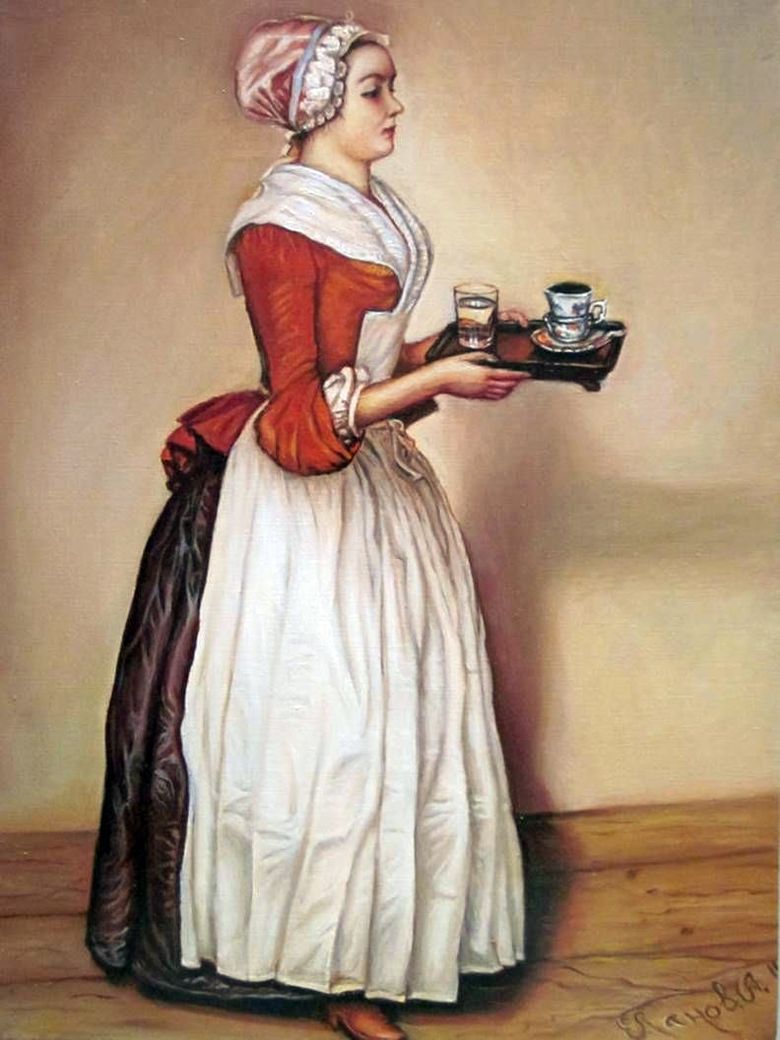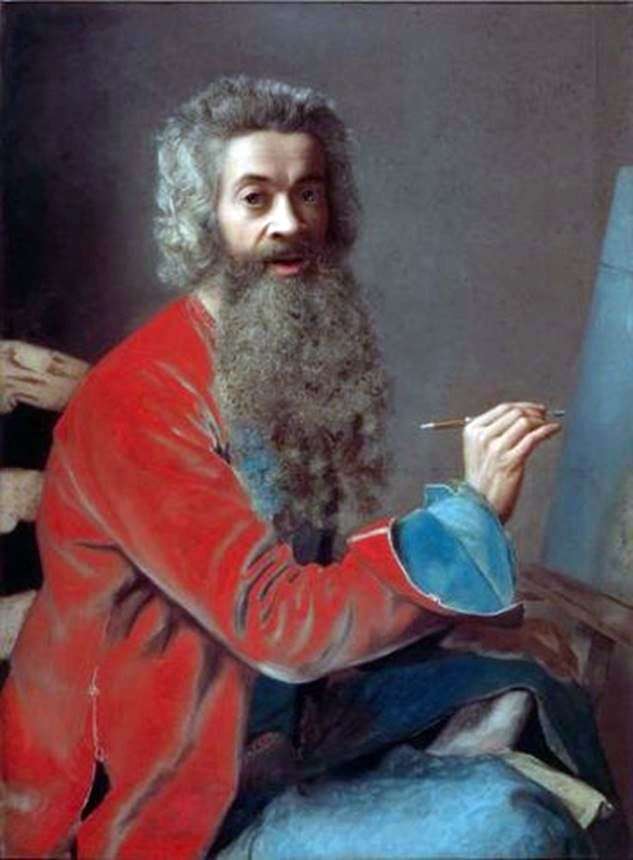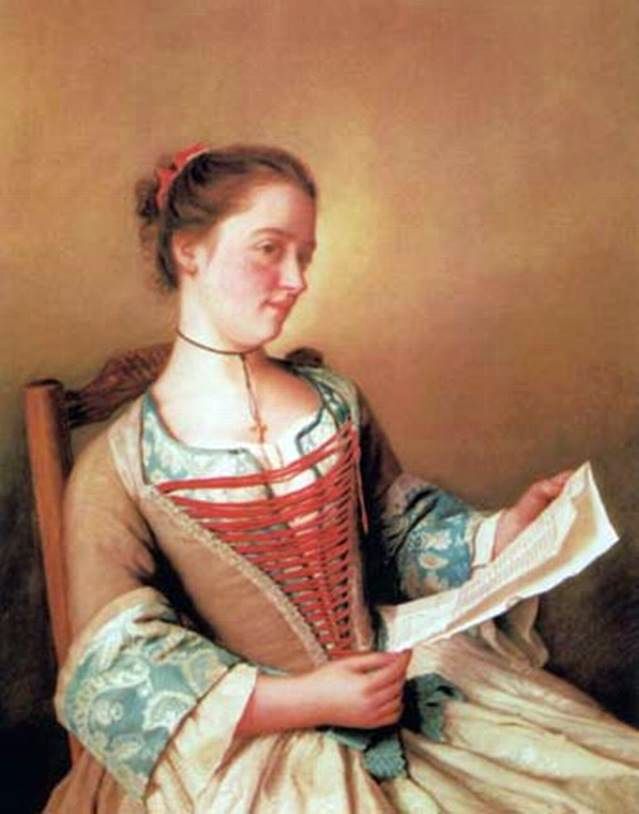
The portrait of the beautiful Anna Baldauf, known worldwide as “Chocolate Girl” and copied and engraved countless times, was written in Vienna.
Most likely, Anna was a servant at the court of the Austrian Empress Maria Theresa, where the painter noticed the girl. Anna, the daughter of an impoverished knight, served as a housemaid at the court. They say that it was there that the young prince Dietrichstein noticed her beauty. He fell in love and, to the horror of the aristocracy, married her.
As a wedding gift, Prince Dietrichstein commissioned Jean Étienne Liotare, who was working at the Viennese court at that time, a portrait of his bride in the very clothes in which he first saw her. They say that on the wedding day, the bride invited the familiar chocolates and, being happy with her elevation, gave them her hand with the words: “Here! Now I have become a princess, and you can kiss my hand.” This painting is also notable for the fact that the first porcelain of Europe was first depicted on it – Meissen. Now this painting is in the Dresden art gallery, but originally it was bought by the Venetian Count Algarotti, an expert and a lover of painting. In one of his letters, he said: “I bought the famous Lyotard pastel. It is executed in inconspicuous degradations of light and with excellent relief.
The transmitted nature is not at all changed; Being a European work, pastels are performed in the spirit of the Chinese… sworn enemies of the shadows. As for the completeness of the work, we can say in one word: this is Holbein pastels. It shows the profile of a young German girl maid who carries a tray with a glass of water and a cup of chocolate. Indeed, the picture shows only one female figure. But it is depicted in such a way that most viewers who visit the famous gallery in Dresden are bewitching to themselves. J.-E. Lyotard managed to give the picture the character of the genre scene.
There is free space in front of “Chocolate Girl”, so the impression is that the model does not seem to be posing to the artist, but passes in small steps in front of the viewer, carefully and carefully carrying the tray. The eyes of the “Chocolate Girl” are modestly lowered, but the consciousness of her attractiveness illuminates her tender and sweet face. Her posture, the position of the head and hands – everything is full of the most natural grace. Her little leg in a gray high-heeled shoe looks modestly from under her skirt.
The colors of the “Chocolate” clothes are chosen by J.-E. Lyotard in soft harmony: a silver-gray skirt, a golden bodice, a sparkling white apron, a transparent white kerchief and a fresh silk cap – pink and delicate, like a rose petal… The artist does not deviate from the most detailed form body “Chocolate Girl” and her clothes. So, for example, the dense silk of her dress is really really bristling; the folds of the apron, which had just been taken out of the laundry drawer, were not straightened yet; a glass of water reflects the window, and it reflects the line of the upper edge of the small tray. The painting “Chocolate Girl” is distinguished by completeness in every detail, which J.-E. Lyotard Art critic M. Alpatov believes that “because of all these features,” Chocolate Girl “
After the conventions and mannerisms of some masters of the 18th century, the almost photographic accuracy of the painting by J.-E. Lyotard gave the impression of revelation. The artist worked exclusively in the pastel technique, very common in the XVIII century, and owned it perfectly. But J.-E. Lyotard was not only the masterly master of this technique, but also its staunch theorist. He believed that it was pastel that most naturally conveys the color and subtle transitions of light and shade within bright, colorful hues.
The very task of showing a figure in a white apron against a white wall is a difficult pictorial task, but in J.-E. In combination with a gray-gray and white apron with pale-gray shades and a steel tint of water, Lyotar is a real poetry of colors. In addition, using thin transparent shadows in “Chocolate Girl”, he achieved perfect accuracy of the pattern, as well as maximum convexity and certainty of volumes.
 Mademoiselle Lavergne, artist’s niece by Jean-Etienne Lyotard
Mademoiselle Lavergne, artist’s niece by Jean-Etienne Lyotard Retrato de la emperatriz austriaca María Teresa – Jean-Étienne Liotard
Retrato de la emperatriz austriaca María Teresa – Jean-Étienne Liotard Self-portrait with a beard by Jean-Etienne Liotard
Self-portrait with a beard by Jean-Etienne Liotard La Chocolatière – Jean-Etienne Lyotard
La Chocolatière – Jean-Etienne Lyotard Portrait of the Austrian Empress Maria Theresa by Jean-Étienne Lyotard
Portrait of the Austrian Empress Maria Theresa by Jean-Étienne Lyotard Shokoladnitsa – Jean-Étienne Lyotard
Shokoladnitsa – Jean-Étienne Lyotard Autorretrato con barba – Jean-Etienne Liotard
Autorretrato con barba – Jean-Etienne Liotard Mademoiselle Lavergne, nièce d’artiste – Jean-Etienne Lyotard
Mademoiselle Lavergne, nièce d’artiste – Jean-Etienne Lyotard